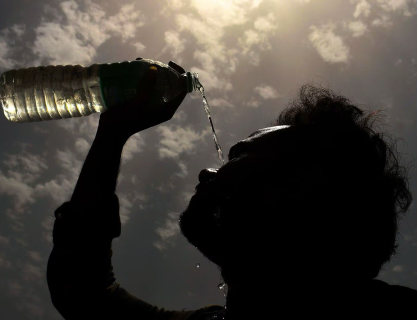Our planet is sick and we are at the root of its inordinate affliction.
The world is sweltering in the heatwaves of 2024, and it isn’t only a climate issue. The torridity lays bare the
omnishambles that is our capacity to tackle climate change. More like any of the many crisis our world is ensnarled in – the severity of climate change ramifications – are divided. A compound of socio-economic and regional divides is ensuing heatwave casualties for some and a really irky inconvenience for others. This scorching episode, characterised by record-breaking temperatures and prolonged periods of intense heat, stretched across continents, leaves a trail of devastation. Unfortunately, the trail is almost certain to continue and likely to be more excruciating for the world.
Hence, the fundamental question must prevail – can we do something? Before answering the question, let’s take a gross cognisance of skyrocketing temperatures, around the world.
A Fiery Start: India in the Throes of Heat
The heatwave’s story began in India. As early as April, the Indian Meteorological Department (IMD) predicted an
above-average summer due to a combination of factors, including the waning El Niño event and changes in regional
weather patterns. This prediction proved tragically accurate.
In May, large swathes of India, particularly central and northwestern regions, were engulfed by a brutal heatwave.
Temperatures soared past 50°C (122°F) in some areas, exceeding previous records by several degrees. Major cities like New Delhi, Mumbai, and Chennai became furnaces, with even nights offering little respite. The scorching heat crippled daily life, disrupting power grids due to surging demand for air conditioning, impacting agricultural production, and causing severe health concerns.
India’s neighbour and arch-nemesis, Pakistan, might share little of anything with it, however, the two did share the illimitable agony caused by the heatwaves. Temperatures rose above 52 degrees Celsius (125.6 degrees Fahrenheit) in Pakistan’s southern province of Sindh, the highest reading of the summer and close to the country’s record high. In Mohenjo Daro, a town in Sindh known for archaeological sites that date back to the Indus Valley Civilization built in 2500 BC, temperatures rose as high as 52.2 C (126 F) over the last 24 hours, a senior official of the Pakistan Meteorological Department, Shahid Abbas reported. “Pakistan is the fifth most vulnerable country to the impact of climate change. We have witnessed above normal rains, floods,” Rubina Khursheed Alam, the prime minister’s coordinator on climate, said at a news conference on Friday adding that the government is running awareness campaigns due to the heatwaves.
Other blistering Asian countries include, the Philippines, where the heat indices peaked at 53°C (127 °F) in Iba, leading to school closures across the country; in Thailand temperatures have broken record nonstop for 13 months.
A Global Phenomenon: Heat Spreads Across Continents
Asia isn’t alone in this fiery ordeal. The heatwave’s grip extends across the globe, affecting regions unaccustomed to such extreme temperatures. Europe witnessed its share of scorching days, with countries like France, Spain, and Italy experiencing record-breaking heat. Wildfires raged across these regions, further exacerbating the heat and air pollution. In Cyprus and Greece, temperatures soared past 40°, leaving multiple dead. At least five tourists, including UK TV doctor and journalist Michael Mosley, have died in Greece over the last few weeks. A missing American tourist was found dead on the beach on a small island west of Corfu Un Sunday, according to local media reports. The remains of a Dutch tourist were found on the eastern Greek island of Samos on Saturday. These are just the latest in a series of cases where visitors disappeared or fell ill after setting out on hikes in the extreme heat. Whereas, southern Europe is particularly vulnerable due to the arrival of warm air from North Africa.
Italy is currently baking in their first big heatwave of the summer with an African anticyclone boosting temperatures up as far as a sweltering 40C. That is 10C above seasonal averages, says Antonio Sand, founder of the weather website ilmeteo.it. By the end of the week, thermometres will register 39-40C in Rome, Naples and Florence, while they will reach 42-44C in inland parts of Sardinia and Sicily. Meanwhile, temperatures in Türkie last week were around 8 to 12C higher than the season average. Maximum temperatures reached 40C and above in many cities. In Istanbul, warnings were issued to vulnerable groups such as the elderly, sick, pregnant women and children against prolonged exposure to the sun. High humidity levels also posed a challenge to those trying to cool off.
The greatest sporting event of the world, the Olympics, to be held in Paris, France, this year, too is in a predicament due to the blazing summer. The risk of heatwaves at the Paris Olympic Games has left organisers sweating about the safety of athletes. Spain is bracing itself for another blistering summer, releasing a new map to help with more accurate heatwave predictions.
North America too felt the heat’s wrath. The western United States and parts of Canada grappled with intense heat and wildfires. Death Valley, California, reached a staggering 57°C (134°F), potentially the highest temperature ever reliably recorded on Earth. A sizzling heat wave in North America has more than 70 million people in the US under heat alerts, with warnings also issued in four Canada provinces. The extreme heat has been described by the National Weather Service as the region’s first significant heatwave of the season. Even South America is no exception in case of the fierce heatwaves. The region is confronted with a severe heatwave. On 11 March, Buenos Aires in Argentina recorded its highest-ever temperature for March at 38.6°C, while Mercedes in Uruguay saw the temperature soar to a record value of
40.5°C.
In midst of conflicts and famines, the onset of heatwaves in Africa has engulfed the region into veritable gloom and grimness. Temperatures soared above 48C in Mali last month with one hospital linking hundreds of deaths to the
extreme heat. Researchers say human activities like burning fossil fuels made temperatures up to 1.4C hotter than
normal. A number of countries in the Sahel region and across West Africa were hit by a strong heatwave that struck at the end of March and lasted into early April. A new analysis from scientists involved with the World Weather
Attribution group suggests the high day time and night time temperatures would not have been possible without the
world’s long term use of coal, oil and gas as well as other activities such as deforestation. According to the study, climate change meant temperatures were up to 1.5C warmer than normal in Mali and Burkina Faso, and made the night even hotter at 2C above the average. Across the region as a whole the five-day temperature was increased by 1.4C. The situation was further exacerbated due to the muslim holy moth of fasting, Ramadan, which augmented the impact of the prevailing torridity. It is noteworthy that Africa is already prone to water scarcity and rising temperatures are making matters worse for countries like Zambia and Zimbabwe. If such a trend of global temperatures breach continues then the region is certain to perish from huger, dearth of water and sizzling heat.
Australia too is struggling with heatwaves, especially its south-eastern region, where unprecedented temperatures have been recorded. Therefore, a sweeping analysis of worldwide temperatures recorded in 2024 are evident that the year is treading to be the hottest ever on record; beating its predecessor, 2023, to the title. Although it is true that the ongoing El Niño weather pattern has amplified the temperatures; it is also unequivocal that human induced changes in the climate are propelling these catastrophic developments across the world.
El Niño is a cyclical climate pattern typically associated with warmer global temperatures. As El Niño transitioned to a neutral state in 2024, regional weather patterns shifted, leading to stagnant air masses and prolonged periods of scorching heat over certain areas.






